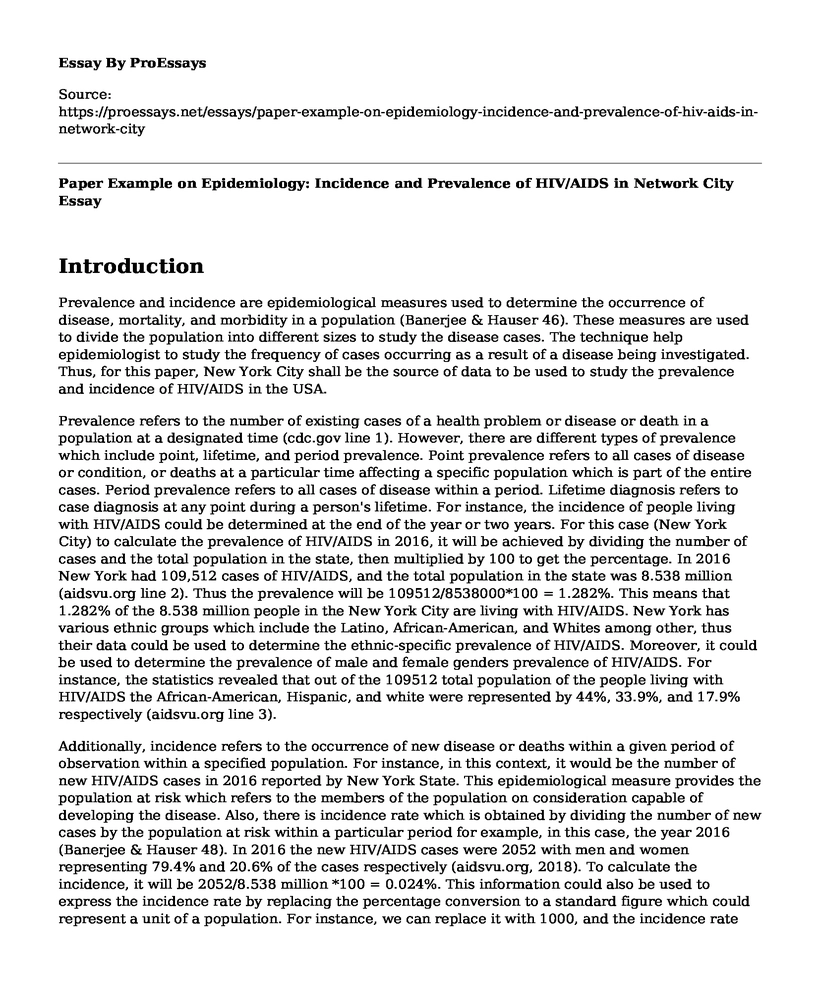Introduction
Prevalence and incidence are epidemiological measures used to determine the occurrence of disease, mortality, and morbidity in a population (Banerjee & Hauser 46). These measures are used to divide the population into different sizes to study the disease cases. The technique help epidemiologist to study the frequency of cases occurring as a result of a disease being investigated. Thus, for this paper, New York City shall be the source of data to be used to study the prevalence and incidence of HIV/AIDS in the USA.
Prevalence refers to the number of existing cases of a health problem or disease or death in a population at a designated time (cdc.gov line 1). However, there are different types of prevalence which include point, lifetime, and period prevalence. Point prevalence refers to all cases of disease or condition, or deaths at a particular time affecting a specific population which is part of the entire cases. Period prevalence refers to all cases of disease within a period. Lifetime diagnosis refers to case diagnosis at any point during a person's lifetime. For instance, the incidence of people living with HIV/AIDS could be determined at the end of the year or two years. For this case (New York City) to calculate the prevalence of HIV/AIDS in 2016, it will be achieved by dividing the number of cases and the total population in the state, then multiplied by 100 to get the percentage. In 2016 New York had 109,512 cases of HIV/AIDS, and the total population in the state was 8.538 million (aidsvu.org line 2). Thus the prevalence will be 109512/8538000*100 = 1.282%. This means that 1.282% of the 8.538 million people in the New York City are living with HIV/AIDS. New York has various ethnic groups which include the Latino, African-American, and Whites among other, thus their data could be used to determine the ethnic-specific prevalence of HIV/AIDS. Moreover, it could be used to determine the prevalence of male and female genders prevalence of HIV/AIDS. For instance, the statistics revealed that out of the 109512 total population of the people living with HIV/AIDS the African-American, Hispanic, and white were represented by 44%, 33.9%, and 17.9% respectively (aidsvu.org line 3).
Additionally, incidence refers to the occurrence of new disease or deaths within a given period of observation within a specified population. For instance, in this context, it would be the number of new HIV/AIDS cases in 2016 reported by New York State. This epidemiological measure provides the population at risk which refers to the members of the population on consideration capable of developing the disease. Also, there is incidence rate which is obtained by dividing the number of new cases by the population at risk within a particular period for example, in this case, the year 2016 (Banerjee & Hauser 48). In 2016 the new HIV/AIDS cases were 2052 with men and women representing 79.4% and 20.6% of the cases respectively (aidsvu.org, 2018). To calculate the incidence, it will be 2052/8.538 million *100 = 0.024%. This information could also be used to express the incidence rate by replacing the percentage conversion to a standard figure which could represent a unit of a population. For instance, we can replace it with 1000, and the incidence rate will be 2052/8.538 million *1000 = 0.24. Thus, the rate of new cases of developing in New York is 0.24.
Conclusion
In conclusion, prevalence and incidence are the epidemiological measures to show how the disease spread and how they cause mortality and morbidity at a given time in a population. These measures are used to establish a mechanism to control disease in a population.
Works Cited
aidsvu.org. 'Local Data: New York City.' (2018). Retrieved fromhttps://aidsvu.org/state/new-york/new-york-city/.
Banerjee, Poonam Nina, and W. Allen Hauser. "Incidence and prevalence." Epilepsy: a comprehensive textbook 1 (2008): 45-56.
cdc.gov, Statistics overview: 'HIV Surveillance report.' (2018). Retrieved from https://www.cdc.gov/hiv/statistics/overview/index.html
Cite this page
Paper Example on Epidemiology: Incidence and Prevalence of HIV/AIDS in Network City. (2022, Jun 30). Retrieved from https://proessays.net/essays/paper-example-on-epidemiology-incidence-and-prevalence-of-hiv-aids-in-network-city
If you are the original author of this essay and no longer wish to have it published on the ProEssays website, please click below to request its removal:
- Sensory Processing Disorder (SPD) Paper Example
- Pharmacology in Disasters and Trauma Essay Example
- Ethical Considerations of Human Cloning Essay Example
- Paper Example on U.S. vs. Canada: Comparing Health Care Cost and Quality
- Strategies for Optimizing Hospital Performance & Safety - Essay Sample
- Essay Example on Crew Resource Management: Prioritizing Patient Safety & Clinical Success
- Paper Example on Marijuana: A Misunderstood Drug, From Childhood to Adulthood







